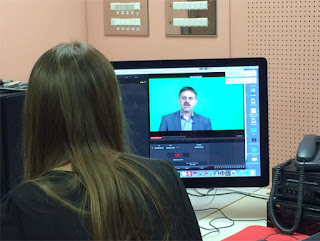The Centre for Excellence in Learning and Teaching (CELT) at the National University of Ireland, Galway is a staff-facing central unit which has the broad aim to enhance the quality of teaching and learning at the University. The centre is responsible for various types of activities, grounded in the promotion of good pedagogy, including the support of learning technologies and media production. In the last 5 years, we have seen an increase in the use of video in online, blended and on-campus courses, including the flipped classroom approach.
With a small complement of staff (just 4 members in the learning technologies team) to support an institution with about 17,000 students and 2,500 staff across 5 Colleges, we have to be selective in how we allocate our resources. We have a small recording studio, for video and audio, with facilities for video editing. Our approach is to empower academic staff to develop their own resources through a combination of technology provision, formal and informal training, advice, support and good practice guides.
There is an impression that video is inherently complicated and that advanced knowledge and skills are necessary to produce anything worthwhile. However, increasingly people are walking around with a smartphone video camera in a pocket, and this is particularly true for our students. We can create and upload a short video to YouTube or Facebook in seconds, so why not educational video too?
Since 2011 we have used the Kaltura platform and VLE (Virtual Learning Environment) building block to make video easier for all staff and students. Instructional videos, webcam or screen recordings can be created and uploaded to the VLE using simple tools that don't require anything more complicated than a webcam and headset, and no knowledge of video files and formats.
While having a technological solution is a necessary first step to support and grow the use of video as a mainstream teaching and assessment tool across campus, it's not sufficient. The CELT learning technologies team is involved in a range of activities to raise awareness and enable the whole university community to leverage the power of video in teaching and learning, including:
- provision of basic advice and support, through a ticketing helpdesk, online resources and good practice guides for self-support. Online resources include both text guides with screenshots as well as video guides using the tools themselves.
- highlighting and showcasing existing good examples of video that have been well integrated into the curriculum.
- hands-on training through workshops on using the tools and technologies for video. The workshops can be stand-alone or included in staff development technology events.
- embedded in the formal CELT professional development programmes (PG Cert in Teaching and Learning in Higher Education, PG Dip in Academic Practice), thereby situating the use of video technology firmly within the pedagogic context.
- leading by example, by making use of video in our own teaching and training activities, even when the focus is not video.
- working closely on selected, defined projects with individual staff and/or student groups, thereby creating showcase opportunities.
- provision of recording and editing facilities and services, where appropriate and feasible.
Republished with permission.
Tweet


No comments:
Post a Comment